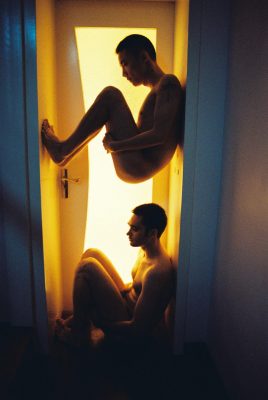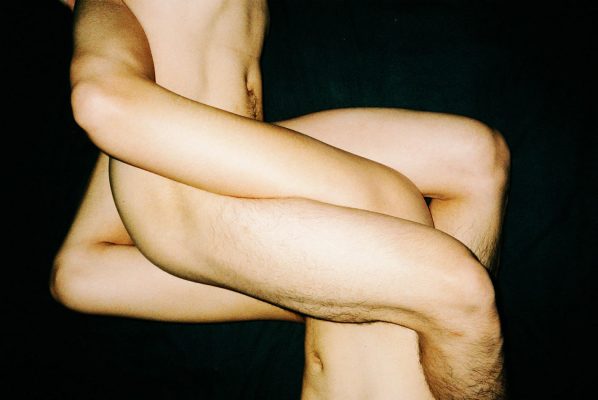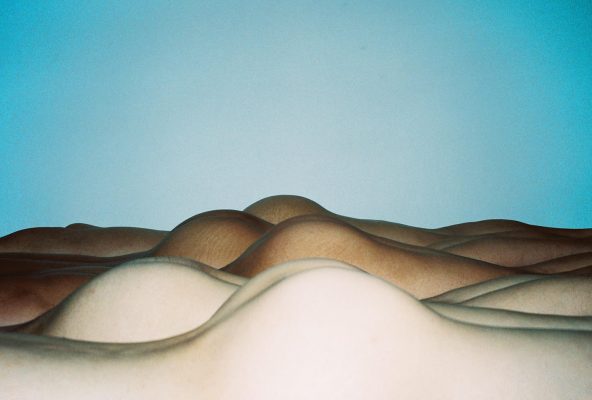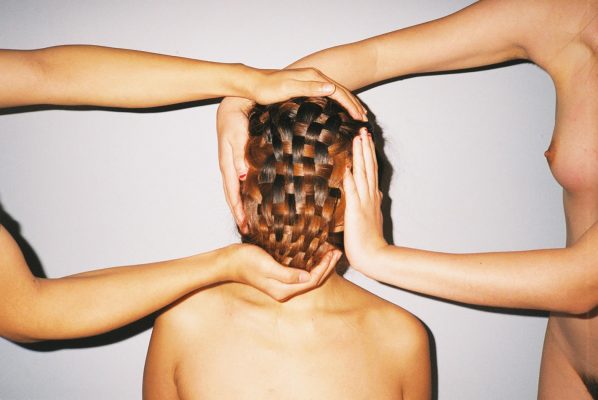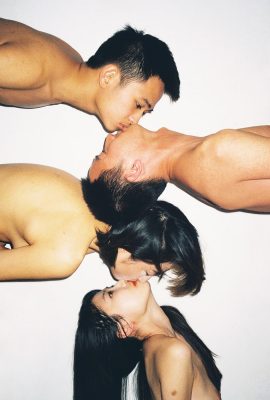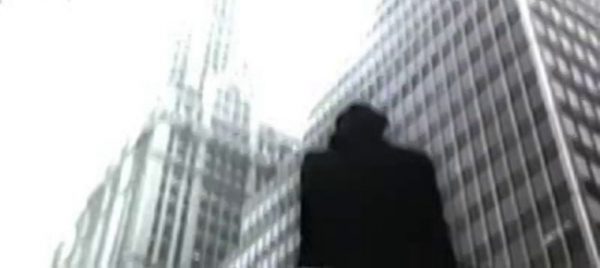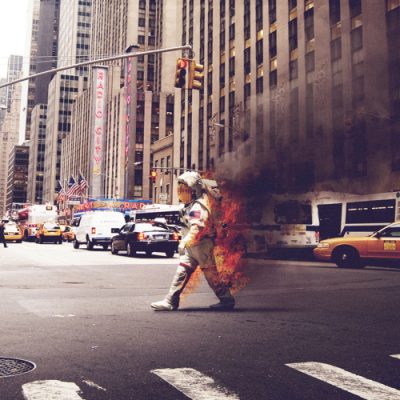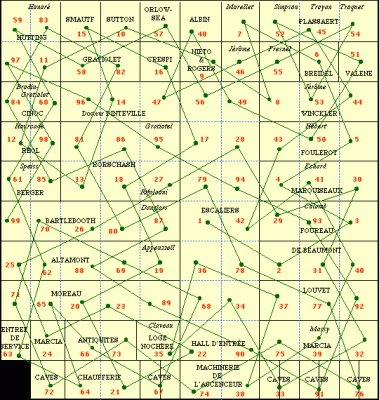When Ren Hang started taking photos, he was a 19-year-old advertising student in Beijing. He would arrange his friends’ naked bodies, often in small white bedrooms, but also hanging off trees, submerged in streams, embracing on the tops of buildings. The title of Hang’s recent retrospective at C/O Berlin, ‘Love, Ren Hang’ (2019-20), foregrounds the vulnerability of his subjects, as well as the friendship that holds that vulnerability, that seems to make it possible. The title is also the end of a letter, a valediction that perhaps references Hang’s death by suicide in 2017, at the age of 29. Hang’s body of work evidences the delicacy of connection, and despite this, the persistent desire to touch. His subjects grab at each other, hold mouths open, cup crotches, and contort around each other in often disorienting ways. Each photograph seems interested in the body in relation, and in playing with the possibilities of contact.
When I saw the exhibition in February, I had been thinking a lot about exes. Or, I was thinking a lot about how we are all arranged around each other. I had recently moved to Berlin and reconnected with an ex who lives here. We’d dated for two years in London, but that ended in 2013. Finding ourselves living in the same city again, we are building a new friendship on the foundations of that old relationship. In December, we were at a sex-positive queer feminist techno party. The night had a set of guidelines pasted around the club, guidance primarily about the darkroom and the necessity of consent. The instructions were a reminder to take care of each other, to be careful with each other’s bodies. At some point, on the dance floor, my ex put her hand on my waist to move me so she could get to the bar. It was just a small moment of contact, but it shocked me. The touch was firm, her hand displayed a familiarity with my body. My body, in turn, remembered so clearly what it felt like to be touched by her. Here we were, after many years, dancing together, our bodies in intimate proximity. Only it was different than all those years ago, reconfigured. What had been a relationship of desire is now something else; those past touches structure the care we show each other now. I can feel that first relationship running underneath this new one. She reached down and touched it when she touched my waist.
Hang’s work is often read as having a sexual politics. The exhibition at C/O Berlin included a warning sign at the entrance: ‘Individual artworks in the current exhibition might hurt your personal feelings, or offend your moral sensibilities.’ Early in his career he had to self-publish books of his photographs, knowing that larger Chinese publishers wouldn’t take on the material for fear of facing obscenity charges. As well as pushing at the boundaries of the supposedly obscene or pornographic, Hang’s images also confront gender and sexual norms – Aperture magazine featured Hang’s work on the cover of their ‘Queer’ issue in 2015. This play with norms is sometimes loosely tied to Hang’s identity as a gay man, something that he never hid but also never publicly discussed at length. In many of his photos, women hold one another, men’s bodies are entangled. In others, the body is turned into genderless form, landscapes of flesh, figures are piled up or curled into each other. Hands with red nails emerge from outside the frame to grab at a central subject – gripping flesh, clutching at genitals.
It is this aspect of his work that is the hardest to unpack, this interest in pushing at what forms human bodies can take in relation to each other. But it is this aspect that is perhaps the queerest. Gender and sexual norms shape our bodies, dictate who we can press them up against, and limit the kinds of touches that are deemed acceptable and desirable. Heteronormativity, among other things, directs desire in certain ways, it aims to orient bodies into particular relationships with each other. Think of the homophobic term ‘bent’. To be ‘bent’ is to be misshapen, to be malformed, to be pointed in the wrong direction. In bending bodies out of shape, queerness draws attention to the force and limitations of straightness. It proffers a challenge to the norms of desire’s orientations, to the patterning of bodies socially. Perhaps a queer aesthetics or queer politics might not have at its centre the individual subject, but instead require at least two bodies (and often many more).
In one of Hang’s images, three women are shown with their hair braided into each other’s, locked together. One woman faces away from the camera, seemingly kneeling, her braid pulled straight up in the air, tied into the braids of the two other women, who stand on either side of her, facing away from each other, heads slightly lowered. None of the women are looking at each other, but their thick black hair holds them all in place. It makes me think of a line from Djuna Barnes’s novel Nightwood (1936). Describing a love triangle between three women, the character Dr Matthew O’Connor laments: ‘in the end you’ll all be locked together, like the poor beasts that get their antlers mixed and are found dead that way, their heads fattened with a knowledge of each other they never wanted, having had to contemplate each other, head-on and eye to eye, until death.’ Dr O’Connor mourns this entanglement, the knowledge that the women have of each other. But I don’t find this image tragic. Desire puts us in strange configurations, bent orientations, and maybe being locked together isn’t so bad.
Ten years ago, I fell in love with a woman (my first), a woman who was also one of my closest friends. We crashed into each other one night, moving from the dance floor to a toilet stall, all desperate hands and open mouths, confirming that our friendship was more complicated than we had been able to admit. This collision was a shock to my sense of self, my friend group, and the relationship I was in at the time. I started seeing a therapist. The friend I had fallen in love with, but who I had decided I couldn’t be with, also started seeing the same therapist. We both loved that therapist and I spent a lot of time talking to that therapist about this friend that I loved. I could never figure out how to be with this friend, we could never get it right, even though we would spend many years dancing around each other. I would sit in the chair in our therapist’s office and think about how my friend, when she came in for her appointments, would sit in this same chair, looking out the same window. Our bodies shared an orientation, sort of. I would sit there, with an awareness of my friend’s body, and wonder if our therapist knew that she had become part of an awkward love triangle. I liked knowing that this very skilled therapist, who was holding me, was also holding my friend. We were all tied together.
In her book Calamities (2016), Renee Gladman describes relationships with lesbian ex-lovers as like building ‘bridges on top of ruined bridges’. For Gladman, these relationships produce an ‘elaborate architecture’ of lovers who tried to make it work, failed, but then kept supporting each other. Why are exes so frequently described via the language of failure? I like Gladman’s insistence on ex-lovers as infrastructure, ruined bridges as somehow supportive, seemingly against all odds. None of Hang’s images have titles or dates, an invitation perhaps to read the works not as discrete or finished objects, but rather as an ongoing and accumulative exploration in making new shapes. Queer people have always had to invent their relationships with few available templates, and I sometimes think it is these creative acts, more than anything else, that are the most challenging to heteronormative culture. Many of Hang’s photos are hard to understand. How many bodies are there? Whose hands are those? What body part is that? How are they balancing? In one photo, four heads are stacked on top of each other, with torsos extending toward the edges of the frame. They look a bit like a strange human ladder. Two women are locked at the lips, and two men are similarly posed. Bodies on top of bodies, heads holding heads, precarious yet supported. How they are sustaining this pose is unclear, but no one looks afraid.
My ex-cat died in January. My ex’s cat died in January. The cat who was once my cat, originally our cat, died in January. I had been with this ex for over five years, the cat was with us for three, and when we split up in 2018, the cat spent the last year of her life with her. I happened to be in London when she died, and my ex and I met to mourn together. I sat on the sofa in her new flat. We were side-by-side like we had been for many years. She made coffee and we talked about the cat. Another thing we had done together, for many years. Except this time there was no cat with us, this wasn’t our flat, and this was a different sofa – I had given that old sofa away to some students when I left London for Berlin. We tentatively reached out and touched each other’s legs, to comfort. We hugged. We held each other, as we always had. We were cautious with each other’s bodies, but ultimately wanted to figure out how to still be in contact. Where was it now ok to put our hands? How long could we hold each other? How to make these bodies find new configurations? We set a limit on how long we would be together that day. We knew it would be hard to leave. Our bodies sunk into each other, safe, comfortable. But we both knew that care also looked like getting up, like committing, as much as it hurt, to finding new ways to be. Bodies are made for this too.
